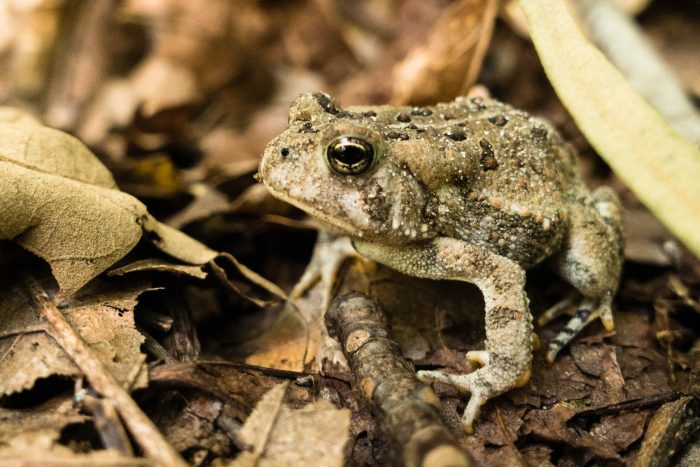Eastern American toad
Anaxyrus americanus
The Eastern American toad is the mostly widely-distributed toad in North America.
This section shows one large critter image at a time. Use the thumbnails that follow to select a specific image to display here.

This gallery contains a grid of small thumbnails. Selecting a thumbnail will change the main image in the preceding section.
Appearance
Eastern American toads vary in color but are typically brown, gray, olive or reddish. In their dorsal area (the mid to upper back) you’ll find dark spots with large warts, typically one to three. Similar looking toads such as the Fowler’s toad and southern toad won’t have these or as many of them. On the toad’s calf, or “tibia,” you’ll also find enlarged warts that are much larger than ones on the thigh. American toads also have a spotted belly. Here is a very helpful video for telling an American toad from other similar looking toads.
Feeding
American toads are opportunistic eaters that consumer large quantities of insects and other invertebrates when they have the chance. American Toads will feed at night on insects attracted to lawn and garden lights, although they will also search for food during late afternoons.
Predators
American toads predators include snakes, raccoons and occasionally birds, raptures and ducks. When confronted by a potential predator, a toad will inflate its lungs, lower its head, and lift up its body, while remaining immobile. They are well camouflaged.
Voice
American toad’s make a long musical quaaaaa sound that lasts up to 30 seconds.
Reproduction and life cycle
In spring, male American toads go to shallow breeding ponds and call out to attract females with a high-pitched call. In water, females discharge their eggs and males fertilize them by discharging sperm into the eggs. The eggs are encased in long spiral tubes of a jelly-like substance, placed on submerged vegetation in shallow water. The tadpoles hatch in 3-12 days and become toads in 50-65 days. American toads usually survive only a year or two in the wild.
Did you know?
- Eastern American toad is the most widely-distributed toad species in North America
- Eastern American toads will form hybrid species with other toads.
- They are often confused with Fowler’s toad and southern toad.
Sources and additional information
- American Toad – Maryland Biodiversity Project
- American Toad – Maryland Department of Natural Resources
- Eastern American Toad – Virginia Herpetological Society
